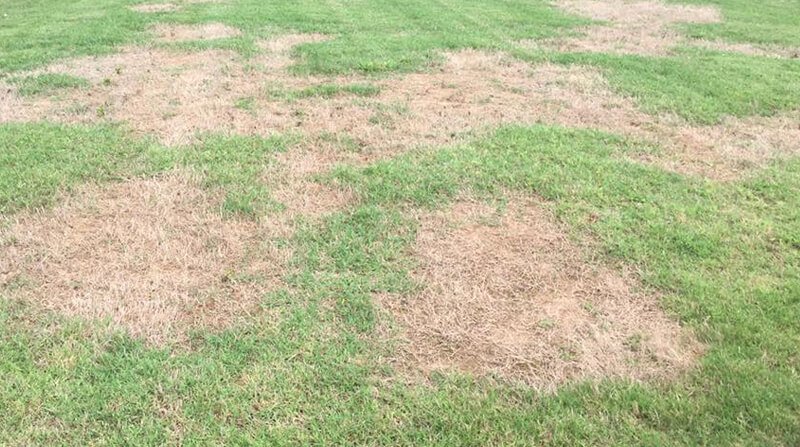Does your lawn suffer from brown patches that don’t recover, no matter how much you water them?
If so, it could be the result of a condition called ‘Dry Patch’. It’s not technically a lawn disease, it’s more a problem within the soil.
In this article, we’re going to get to know what dry patch is, the possible causes and how to fix it, which can be tricky.
What is Dry Patch?
Dry Patch can look like another disease called Take All.
It’s a condition that prevents the soil in your lawn from being able to absorb water. Even after heavy rainfall, the soil will be bone dry. As a result, you’ll see patches of grass dying and turning brown in amongst what is otherwise a healthy lawn.
Compared to other lawn problems, Dry Patch isn’t very well understood and could have several different causes.
Causes of Dry Patch
It’s mainly a dry weather problem and is often associated with heavy soil compaction and thick layers of lawn thatch, particularly in older lawns. You’ll see it on heavily trafficked areas of the lawn and under trees.
One of the most common causes, however, is a type of fungi that grows in amongst the thatch layer and the roots of the grass, coating the soil particles in a water-repellent layer.
Even if the grass has an extensive root system, water doesn’t reach them because it is repelled by the soil. This causes the grass to suffer from conditions of severe drought, even during periods of heavy rainfall.
A similar type of fungi causes Type 1 Fairy Rings in which a ring of soil becomes impenetrable by water and mushrooms grow on the outer edges.
These types of fungi don’t directly affect the grass, rather they break down dead organic material in the thatch layer, like dead grassroots, clippings, and dead leaves or bits of bark. The problem is that it makes the soil water repellent as it spreads.
Other causes of Dry Patch are thought to include shallow soil or chemical and physical changes within the soil.
How to Tell if Your Lawn is Suffering from Dry Patch and Not Something Else
There are many reasons your lawn could turn patchy and brown, but it might not always mean your lawn is suffering from Dry Patch.
Other causes include insects and pests, like Chafer Grubs or Leatherjackets, fungal diseases like Fusarium Patch, Pink Patch and Dollar Spot can look like it. As well as spilled lawnmower fuel, or even dog urine.
So how do can you positively identify Dry Patch?
Symptoms of Dry Patch
If you think your lawn is suffering from Dry Patch look for the following symptoms;
- Irregular patches of your lawn turning a darker green before turning brown
- The soil underneath the grass is completely dry, even after heavy rainfall
- If you apply water to the dry soil it will run off or pool, but not soak in
- Water can puddle on the brown patches after heavy rainfall because the soil cant absorb it
- In some cases (though not all) there will be a musty fungal smell and even white fungal mycelium in the soil
If you spot any of these symptoms, you’re looking at dry patch!
What to Do if Your Lawn Has Dry Patch
If Dry Patch develops in your lawn it can be very difficult to re-wet the soil due it’s hydrophobic properties.
There are two possible fixes;
-
- Aerate the soil and apply a wetting agent to help the soil absorb water
- Replace the soil and turf in the affected areas
Aerate the Soil and Apply a Wetting Agent to Help the Soil Absorb Water
First, scarify your lawn to remove and excess thatch. If the soil is water repellent then scarify deeply. The removal of thatch will take away the food source of the fungi that caused the soil to become hydrophobic in the first place. It will also aid in the recovery.
Then, spike the affected areas of lawn densely and to a depth of 3-4 inches with a garden fork.
And lastly, apply a wetting agent like The Lawnsmith’s Yucca Wetting Agent.
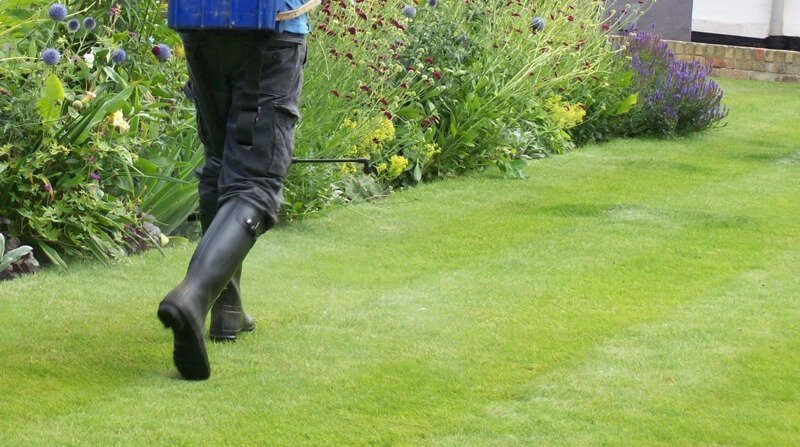
What’s a Wetting Agent?
A wetting agent essentially makes water wetter by breaking its surface tension. This means water droplets spread far more thinly and as a result, the water can more easily penetrate the soil profile.
Chances are, you’ll re-apply the wetting agent once a month for 3-5 months before you see a recovery.
If that doesn’t work, or you want to fix the problem as quickly as possible…
Replace the Turf and Soil of the Affected Area
The other option is to replace the turf and soil in the affected areas of your lawn.
Remove the affected turf, plus 3-4 inches of good-looking turf around it. By removing 3-4 inches extra you can be confident that you’ve not left any fungi which can go on to infect the rest of your lawn.
Next, dig out the soil to a depth of at least 20cm. If you can, dig deeper without affecting the sub-base of your garden, dig to 30cm.
Now, replace the soil with a good quality topsoil and either lay new turf or re-seed the area. If it’s possible, try to match the turf or seed to your existing lawn. There’s nothing more odd-looking than a patch of lawn that looks completely different from the rest.
How to Prevent Dry Patch From Occurring or Re-Occurring
Just like the prevention of weeds or disease, Dry Patch can often be prevented through a proper lawn care regime.
Scarifying Your Lawn to Remove Excess Thatch
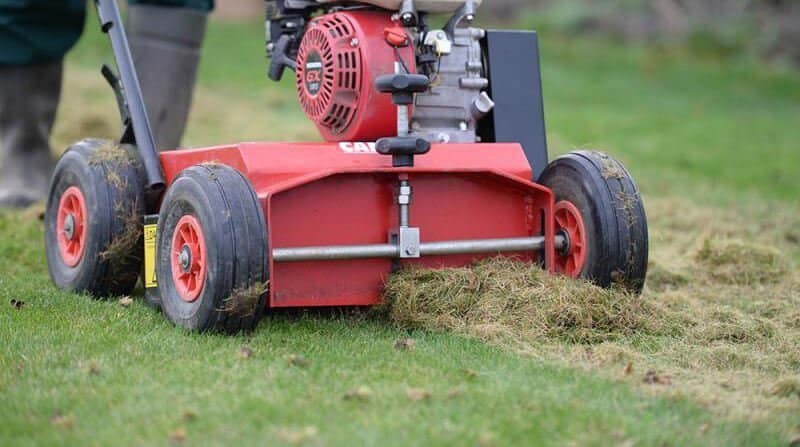
As we discussed earlier, Dry Patch can be caused by the spreading of fungi as it decomposes the dead organic material in the thatch layer.
If the thatch layer is particularly thick, the fungi will spread into the soil as it feeds on the dead organic material which is what thatch is. This causes the soil to become resistant to water and that’s where the problems start.
By scarifying your lawn you remove much of that dead organic matter which means the fungi can’t spread through it and infect the soil.
This also allows water to penetrate the soil much more easily which benefits the grass.
Read: My Top Picks For the Best Lawn Scarifier
Aerating the Lawn to Relieve Soil Compaction
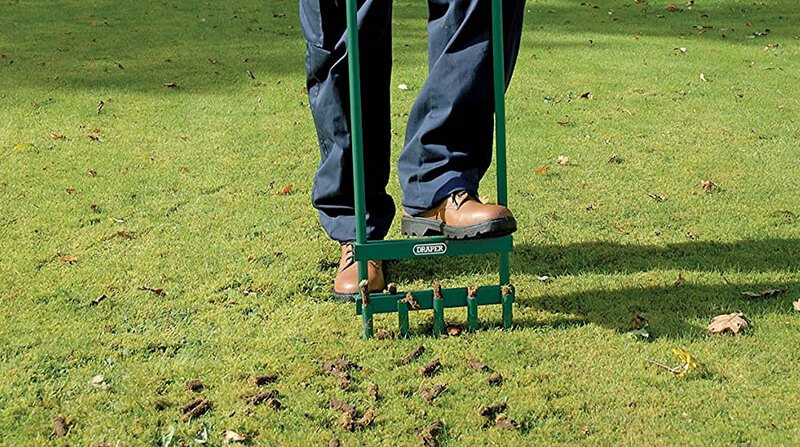
Hard, compact soil can prevent water from penetrating it. Which in turn can cause brown patches in parts of your lawn. Especially areas that are used heavily like around kids goalposts, along the washing line or areas that you walk on regularly.
Aerating your lawn via spiking will allow water to more easily penetrate the soil, as well as oxygen and other nutrients.
Hollow tine aeration removes cores of turf from the lawn. This relieves compaction by allowing the soil particles to relax and separate from each other and move into space you created by removing the cores of turf.
This separation of particles means water can work its way in the soil profile much more easily.
Read: Aerating a Lawn: Why, When and How
Mowing Your Lawn on a Higher Setting

Cutting your grass is so, so important to maintaining a healthy lawn. But because it’s the most common aspect of lawn care, it’s rarely given the respect or consideration it deserves.
Dry Patch is a hot weather condition so keep cutting the grass once every 7-10 days during the summer months. This will help maintain good root strength but keep your lawn mower on a higher setting and just take the top off the grass. NEVER cut more than a third off the height.
Also, leave the clippings on the lawn.
By keeping the grass high and spreading the clippings on the lawn you keep moisture and nutrients in those clippings in the lawn.
Read: In-Depth Guide to Cutting the Grass
Fertilising Will Enable the Grass to Better Control Moisture
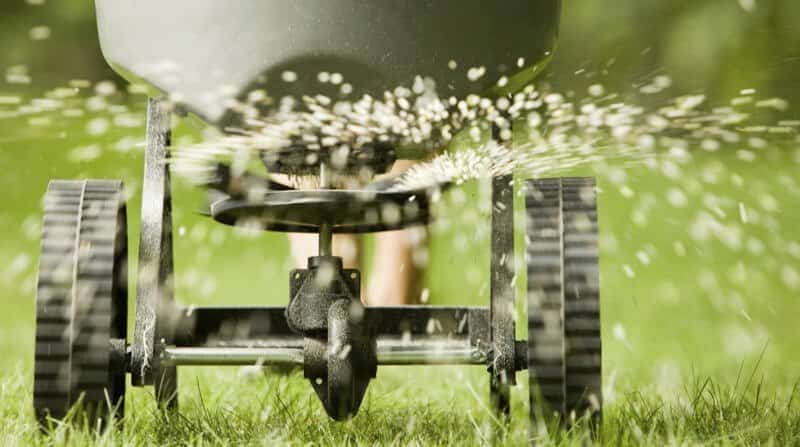
Fertilising your lawn not only provides the nutrients grass needs in order to photosynthesise and produce food, but it also helps the plant’s moisture control mechanism.
Fertilise your lawn in the Spring and Autumn with a fertiliser with a high percentage of Potassium.
This will ensure the grass and its roots can hold on to moisture.
Read: The Lawn Feeds I Recommend
Start a Wetting Agent Program in Early Spring
Apply a wetting agent every 7-10 days during mid-March and April and then once a month until August.
This will ensure that there is the maximum amount of wetting agent in the soil which will hold onto the moisture in the soil when it is most needed in the height of summer.
In Conclusion
Dry patches in your lawn don’t look nice.
But remember, dry patches can be caused by several different things so before you rush ahead and start treating for Dry Patch, make sure it’s not something else first.
Once you have diagnosed Dry Patch, treat it quickly. If it’s being caused by fungal mycelium it can spread quickly so the quicker you act, the less time, effort and money it will cost to fix.
But don’t expect to have it cured in a weekend unless you go the whole way and replace the soil and turf. Treating it with a wetting agent can take months and even then, it’s not guaranteed.
